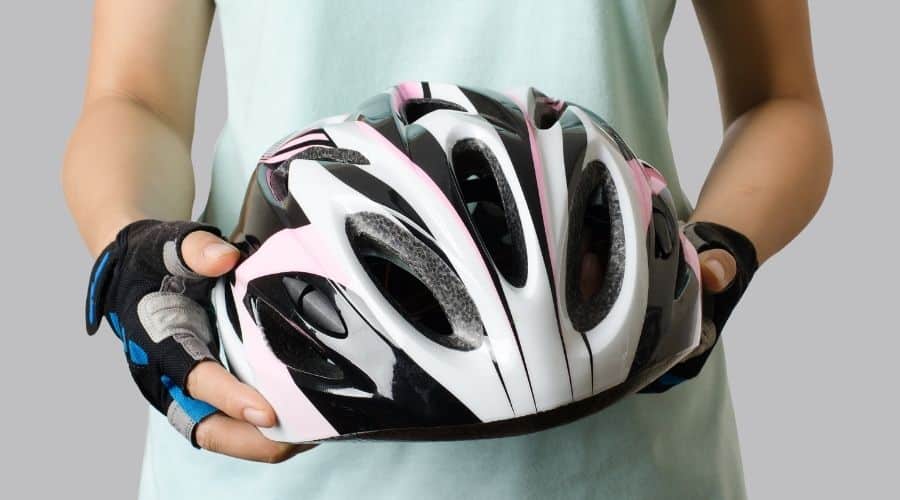Bicycle helmets are not random; the shapes they use are the intentional product of science and careful study on impact. The materials and safety standards for bike helmets, along with the design, contribute to how effective they are at keeping your head safe in case of impact.
Moreover, different helmets serve different purposes. Why are bicycle helmets shaped that way?
Bicycle helmets are rounded, semi-circular, or teardrop shaped in a way to spread the force of an impact over a broader area, so your skull is less likely to fracture. The Expanded Polystyrene foam inside the helmet protects your head by cushioning the blow, while ventilation holes and ridges for aerodynamic movement are shaped for rider comfort and performance.
Recommended Gear
To see all of my up-to-date recommendations for bikes and cycling gear, check out this resource that I made for you!
Table of Contents
Bike Helmet Shapes
Bike helmets tend to be rounded, semi-circular, or tear-drop-shaped with one narrow end and a wider round part.
The shape is determined by how and where it fits over the head. Likewise, ventilation holes and ridges for aerodynamic movement are shaped for rider comfort and to help the style of the helmet be more effective.
There are three main types of bike helmets, the MTB or mountain bike helmet, the recreational or casual helmet, and the road bike helmet.
Each of these fits and protects differently. The materials and shapes vary based on how they handle the motion and impacts each bike style most commonly experiences.
Moreover, they are held to different safety standards and typically have one or more certifications.
1 – Mountain Bike Helmet
Mountain bike helmets are primarily round with smaller vent holes. They are made for off-road riding. Trails and trees are part of the scenery on an MTB, so that you won’t need a visor.
However, this style is designed with more overall coverage for your head because mountain bike accidents are often nasty and involve tumbling downhill.
2 – Recreational Bike Helmet
Recreational helmets come in more colors and styles. If you see a weird-shaped helmet with faux rubber spikes on top or Disney princesses, it’s almost certainly a recreational helmet.
This style isn’t as sleek as a road bike helmet or as chunky and bulky as an MTB helmet.
The recreational helmets are meant for casual riders and hobbyists who are less likely to take a significant tumble down a mountain or have a road accident in traffic.
While they are still good helmets, recreational bike helmets are casual.
They may have a visor and larger vent holes, and they’re more of a half-sphere shape rather than a sleek aerodynamic teardrop, and they often lack the low back of MTB helmets.
3 – Road Bike Helmet
Road bike helmets have three jobs. First, they need to cut through the air, so they have textured vents and tend to narrow toward a point in the back because it helps the rider cut through the air.
This is also the style with a visor to help reduce road glare.
Secondly, road bike riders typically need to stay cool. Reflected heat coming off the road is warmer than that from dirt tracks.
The vents on this type of helmet are larger and more decorative. And lastly, road bike helmets are thicker in the front because most road accidents are head-on collisions.
How Do Bike Helmets Protect Your Head
The Expanded Polystyrene (EPS) foam inside a cycling helmet protects your head by cushioning the blow and spreading out the shock of impact.
When you hit your head, the foam fractures and breaks apart. The result is that you need a new helmet, but not a new head.
Bike Helmet Safety Standards & Certifications
To ensure that the helmet is actually protecting you the way it should. There are different letters attached to the certifications, which stand for organizations that handle the testing.
CE EN and EN are European, AS/NZS is Australian, and ASTM or CPSC are American standards. However, each one implies that the helmet or type of helmet has been through rigorous testing to verify its value and capabilities.
According to Helmets.org, “The ASTM standard is identical to the CPSC standard in all important respects except one. It is a voluntary standard and was never the law of the land in the US. It is self-certifying, so a manufacturer can put a sticker in their helmets stating that they meet the ASTM standard without independent certification.”
Bike helmet certifications are listed below:
- Bicycling (general): CPSC 1203, AS/NZS 2063, CE EN-1078, and EN-1080
- Downhill Mountain Biking: ASTM F1952
- BMX: ASTM F2032 and ASTM F1952
- Dual or Multi-Sport Helmets for Cycling and Skating: ASTM F1492
- E-bikes: NTA 8776
What Are Bicycle Helmets Made Of
Not all bicycle helmets are made the same, but they use a limited number of materials. Dual sport and some bike helmets use ABS or polycarbonate plastic on the outside.
Other cycling helmets use epoxy, fiberglass, carbon fiber, and kevlar. The quality of the shell depends on the intended use and the manufacturer, and more expensive helmets typically use better quality shell materials.
Inside cycling, helmets are made from Expanded Polystyrene (EPS) foam. This is the same foam you see in packaging to help prevent damage during shipping.
Beyond that, a helmet usually has straps with a plastic clasp, and it may have softer foam padding to get the fit just right.
Why Are Mountain Bike Helmets Different
There are four main differences between mountain bike helmets and other styles. All of them can be seen easily.
The first and most obvious is the bulk. As helmets go, this style is weighty, chunky, and round, but there are other, slightly more subtle differences.
Secondly, you will not find a visor on an MTB helmet. Road bikes and some recreational styles use a visor because it’s uncomfortable (or dangerous) to wear sunglasses with your helmet.
Meanwhile, by definition, mountain bikes are often ridden in forests, which means less direct sunlight in the rider’s face.
Third, the back of the helmet comes down to protect the base of the skull. You’ll also see this in dual-sport and skating helmets, where the wearers are more prone to falling backward.
Notably, tumbling down a mountain means hitting more of your head than just the front like you would in a road bike accident.
Finally, there’s the issue of vent holes. MTB helmets don’t have sculpted grooves and large ventilated areas. Mountains tend to be cooler than skate parks and city streets, so airflow is less of an issue.
Helpful Tips To Know About Why Bicycle Helmets Are Shaped That Way
Bicycle helmets come in several shapes, mostly round, half-circle, and a more teardrop or half-eardrop shape. Each style helps protect the human head differently.
Here are more helpful tips to know about why bicycle helmets are shaped that way.
- You may see bike helmets broken into more categories with names that correspond to bicycle styles like BMX, but those helmets still fall within the three basic categories I’ve described. The difference is mostly marketing.
- Bike helmet samples are tested in hot, cold, room temperature, and wet conditions. They do this because any helmet could encounter any of those.
- The straps, buckles, and pads are also tested rigorously before they’re certified for use.
Final Thoughts
The shapes of bike helmets are customized based on the science behind accidents. The densest foam is generally distributed where a rider is most likely to impact.
Road bikes need front protection, while mountain bikes require a more all-over solution.
Other aspects like ventilation and visors are also based on the riders’ everyday needs to suit most people who choose that style.

